VOLVO V60 2021 Owners Manual
Manufacturer: VOLVO, Model Year: 2021, Model line: V60, Model: VOLVO V60 2021Pages: 661, PDF Size: 12.68 MB
Page 251 of 661
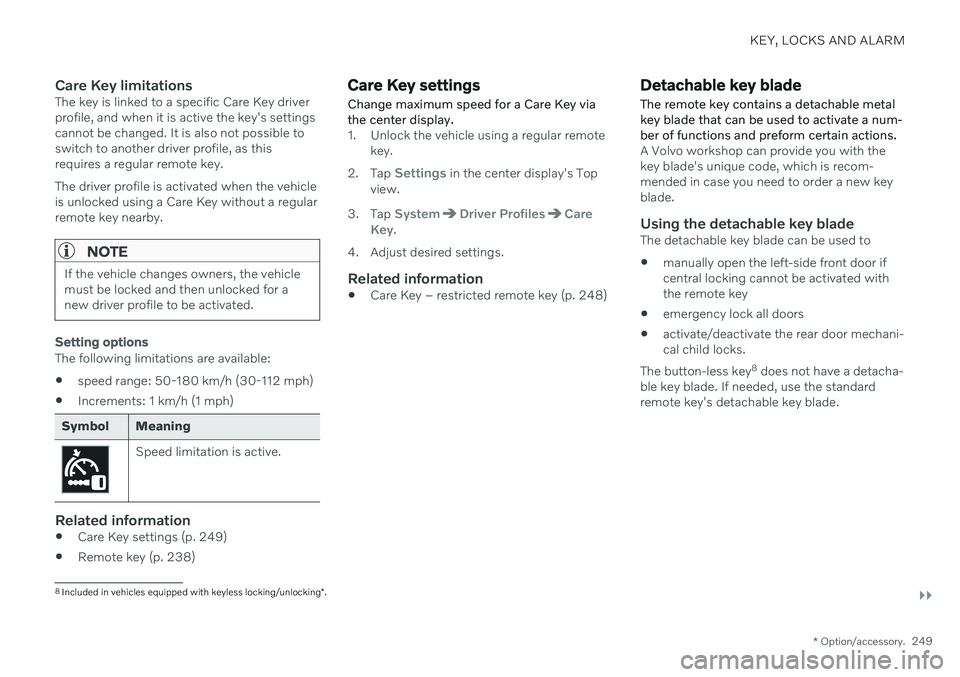
KEY, LOCKS AND ALARM
}}
* Option/accessory.249
Care Key limitationsThe key is linked to a specific Care Key driver profile, and when it is active the key's settingscannot be changed. It is also not possible toswitch to another driver profile, as thisrequires a regular remote key. The driver profile is activated when the vehicle is unlocked using a Care Key without a regularremote key nearby.
NOTE
If the vehicle changes owners, the vehicle must be locked and then unlocked for anew driver profile to be activated.
Setting options
The following limitations are available:
speed range: 50-180 km/h (30-112 mph)
Increments: 1 km/h (1 mph)
Symbol Meaning
Speed limitation is active.
Related information
Care Key settings (p. 249)
Remote key (p. 238)
Care Key settings
Change maximum speed for a Care Key via the center display.
1. Unlock the vehicle using a regular remote key.
2. Tap
Settings in the center display's Top
view.
3. Tap
SystemDriver ProfilesCare
Key.
4. Adjust desired settings.
Related information
Care Key – restricted remote key (p. 248)
Detachable key blade
The remote key contains a detachable metal key blade that can be used to activate a num-ber of functions and preform certain actions.
A Volvo workshop can provide you with the key blade's unique code, which is recom-mended in case you need to order a new keyblade.
Using the detachable key bladeThe detachable key blade can be used to
manually open the left-side front door ifcentral locking cannot be activated withthe remote key
emergency lock all doors
activate/deactivate the rear door mechani-cal child locks.
The button-less key 8
does not have a detacha-
ble key blade. If needed, use the standardremote key's detachable key blade.
8 Included in vehicles equipped with keyless locking/unlocking *.
Page 252 of 661
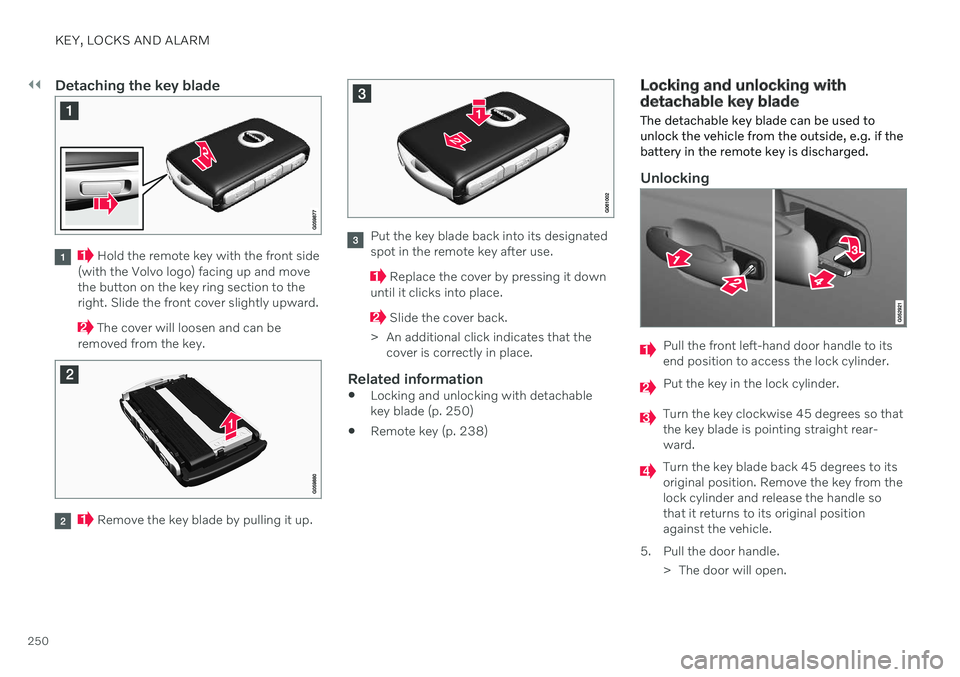
||
KEY, LOCKS AND ALARM
250
Detaching the key blade
Hold the remote key with the front side
(with the Volvo logo) facing up and move the button on the key ring section to theright. Slide the front cover slightly upward.
The cover will loosen and can be
removed from the key.
Remove the key blade by pulling it up.
Put the key blade back into its designated spot in the remote key after use.
Replace the cover by pressing it down
until it clicks into place.
Slide the cover back.
> An additional click indicates that the cover is correctly in place.
Related information
Locking and unlocking with detachable key blade (p. 250)
Remote key (p. 238)
Locking and unlocking with detachable key blade
The detachable key blade can be used to unlock the vehicle from the outside, e.g. if thebattery in the remote key is discharged.
Unlocking
Pull the front left-hand door handle to its end position to access the lock cylinder.
Put the key in the lock cylinder.
Turn the key clockwise 45 degrees so that the key blade is pointing straight rear-ward.
Turn the key blade back 45 degrees to its original position. Remove the key from thelock cylinder and release the handle sothat it returns to its original positionagainst the vehicle.
5. Pull the door handle. > The door will open.
Page 253 of 661

KEY, LOCKS AND ALARM
* Option/accessory.251
NOTE
When the door is unlocked using the detachable key blade and then opened, thealarm will be triggered. The alarm must bedeactivated manually; see separate sec-tion.
LockingThe left-hand front door can be locked by inserting the detachable key into the door'slock cylinder. The other doors have lock mechanisms in the side of the door that must be pushed in usingthe key blade. The door will then be lockedmechanically and cannot be opened from theoutside. The doors can still be opened from inside.
Manual door lock. This is not the child lock.
1. Remove the detachable key blade from
the remote key.
2. Insert the key blade into the opening for the lock mechanism.
3. Push in the key until it stops, about 12 mm (0.5 inch).
The door can be opened from both the outside and the inside.
The door cannot be opened from the out- side. To return to position A, open the doorusing the inside door handle.
NOTE
The door's lock controls only lock that specific door, not all doors simultane-ously.
A manually locked rear door with acti-vated child lock cannot be openedfrom either the outside or the inside.The door can only be unlocked usingthe buttons on the key, the centrallocking button, the keyless locking sys- tem
* or Volvo On Call.
Related information
Detachable key blade (p. 249)
Arming and disarming the alarm (p. 267)
Starting the vehicle (p. 392)
Replacing the remote key's battery (p. 244)
Remote key (p. 238)
Page 254 of 661
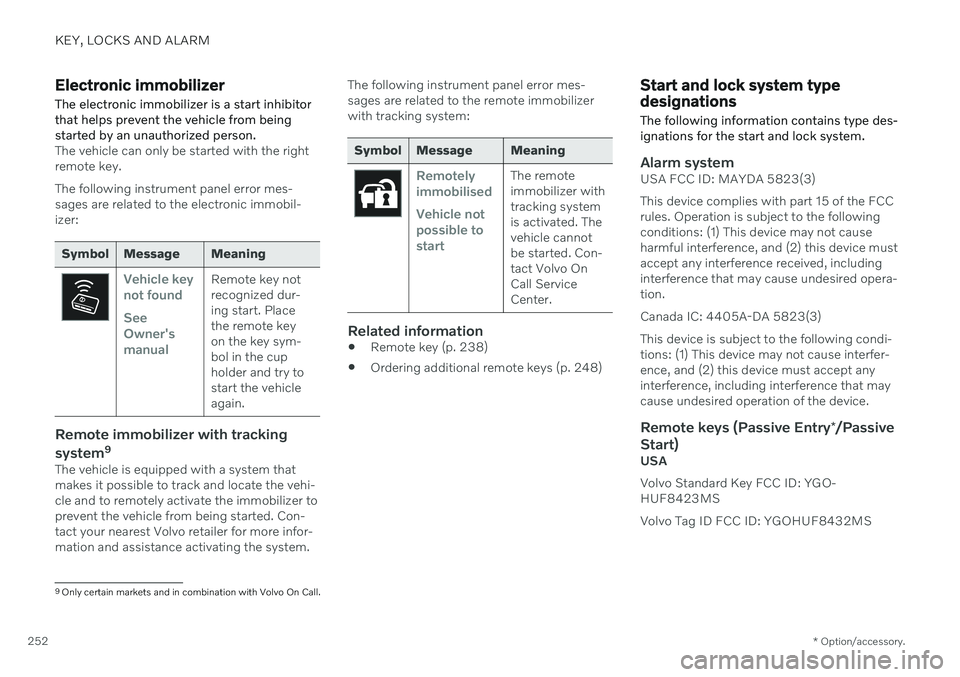
KEY, LOCKS AND ALARM
* Option/accessory.
252
Electronic immobilizer The electronic immobilizer is a start inhibitor that helps prevent the vehicle from beingstarted by an unauthorized person.
The vehicle can only be started with the right remote key. The following instrument panel error mes- sages are related to the electronic immobil-izer:
Symbol Message Meaning
Vehicle key not found See Owner'smanualRemote key not recognized dur-ing start. Placethe remote keyon the key sym-bol in the cupholder and try tostart the vehicleagain.
Remote immobilizer with tracking system 9
The vehicle is equipped with a system that makes it possible to track and locate the vehi-cle and to remotely activate the immobilizer toprevent the vehicle from being started. Con-tact your nearest Volvo retailer for more infor-mation and assistance activating the system. The following instrument panel error mes-sages are related to the remote immobilizerwith tracking system:
Symbol Message Meaning
Remotely immobilised Vehicle not possible tostartThe remote immobilizer withtracking systemis activated. Thevehicle cannotbe started. Con-tact Volvo OnCall ServiceCenter.
Related information
Remote key (p. 238)
Ordering additional remote keys (p. 248)
Start and lock system type designations The following information contains type des- ignations for the start and lock system.
Alarm systemUSA FCC ID: MAYDA 5823(3) This device complies with part 15 of the FCC rules. Operation is subject to the followingconditions: (1) This device may not causeharmful interference, and (2) this device mustaccept any interference received, includinginterference that may cause undesired opera-tion. Canada IC: 4405A-DA 5823(3)This device is subject to the following condi- tions: (1) This device may not cause interfer-ence, and (2) this device must accept anyinterference, including interference that maycause undesired operation of the device.
Remote keys (Passive Entry
*/Passive
Start)
USA Volvo Standard Key FCC ID: YGO- HUF8423MS Volvo Tag ID FCC ID: YGOHUF8432MS
9 Only certain markets and in combination with Volvo On Call.
Page 255 of 661
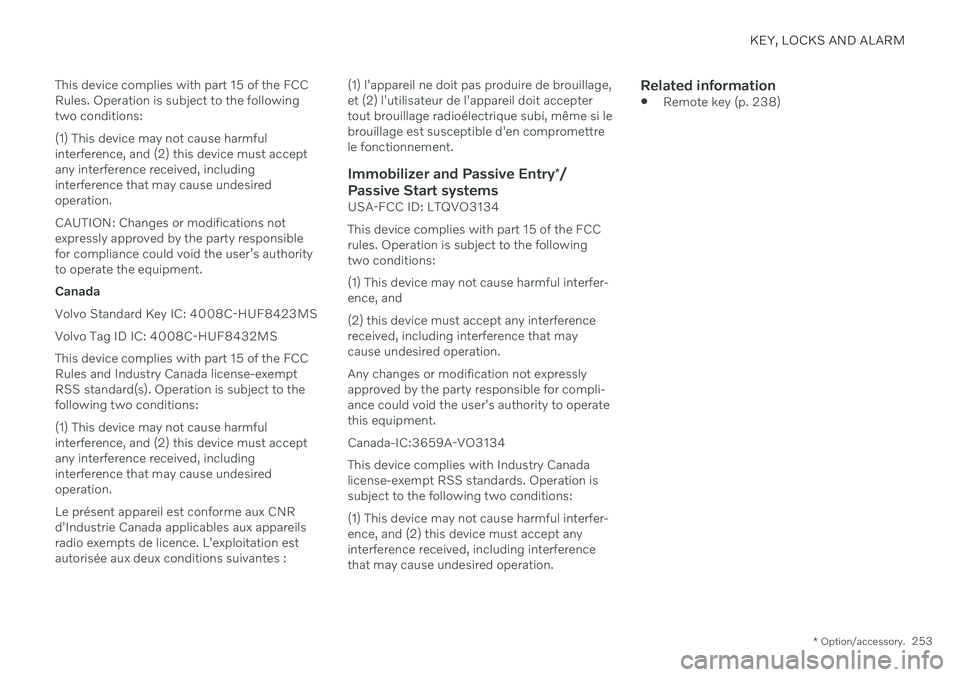
KEY, LOCKS AND ALARM
* Option/accessory.253
This device complies with part 15 of the FCC Rules. Operation is subject to the followingtwo conditions: (1) This device may not cause harmful interference, and (2) this device must acceptany interference received, includinginterference that may cause undesiredoperation. CAUTION: Changes or modifications not expressly approved by the party responsiblefor compliance could void the user
Page 256 of 661
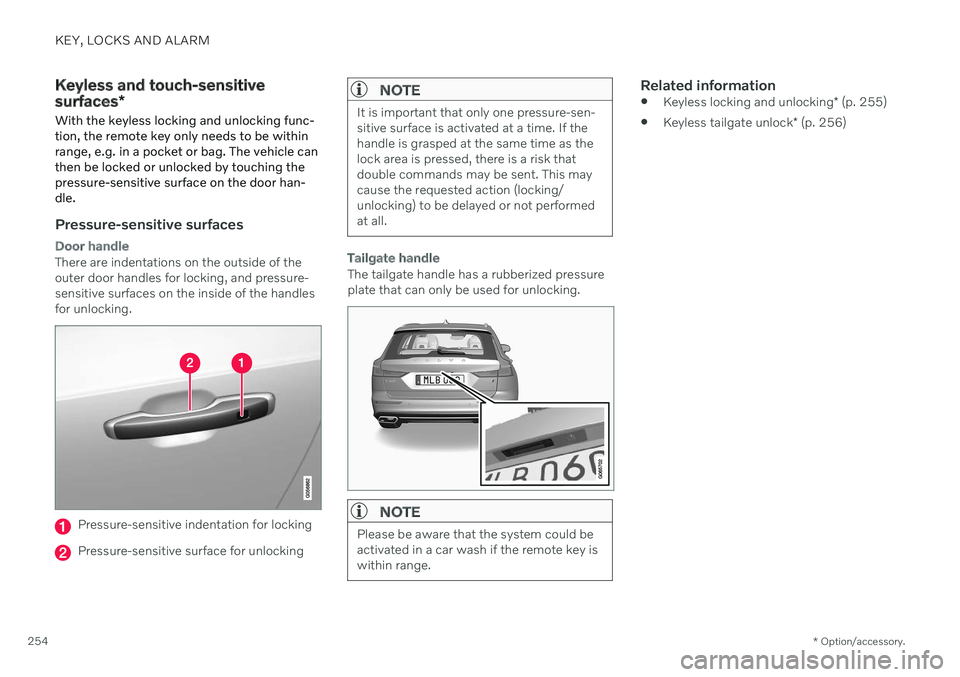
KEY, LOCKS AND ALARM
* Option/accessory.
254
Keyless and touch-sensitive surfaces *
With the keyless locking and unlocking func- tion, the remote key only needs to be withinrange, e.g. in a pocket or bag. The vehicle canthen be locked or unlocked by touching thepressure-sensitive surface on the door han-dle.
Pressure-sensitive surfaces
Door handle
There are indentations on the outside of the outer door handles for locking, and pressure-sensitive surfaces on the inside of the handlesfor unlocking.
Pressure-sensitive indentation for locking
Pressure-sensitive surface for unlocking
NOTE
It is important that only one pressure-sen- sitive surface is activated at a time. If thehandle is grasped at the same time as thelock area is pressed, there is a risk thatdouble commands may be sent. This maycause the requested action (locking/unlocking) to be delayed or not performedat all.
Tailgate handle
The tailgate handle has a rubberized pressure plate that can only be used for unlocking.
NOTE
Please be aware that the system could be activated in a car wash if the remote key iswithin range.
Related information
Keyless locking and unlocking
* (p. 255)
Keyless tailgate unlock
* (p. 256)
Page 257 of 661
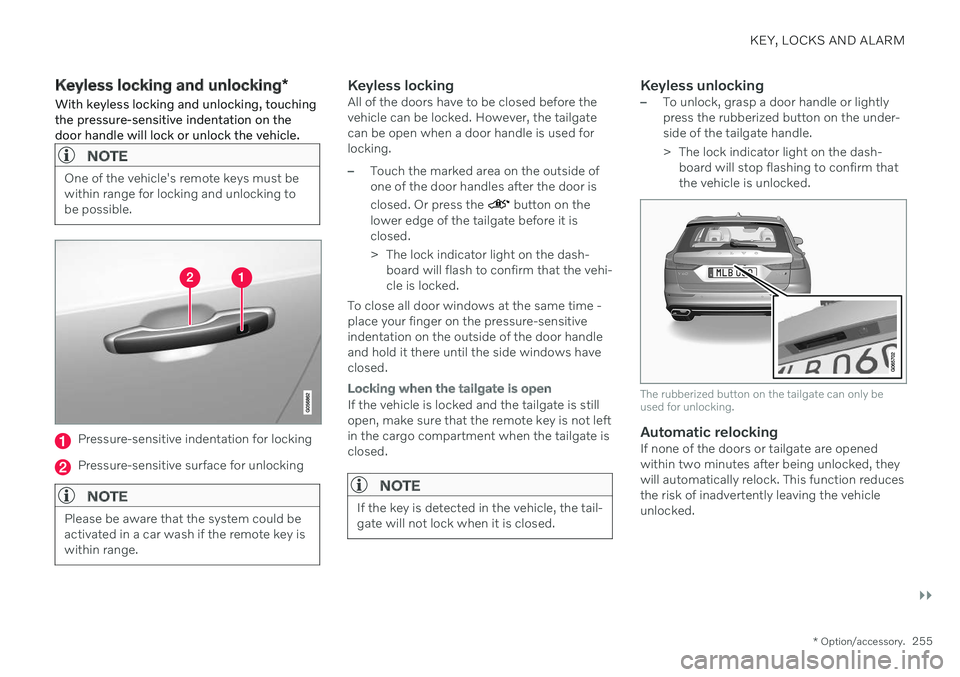
KEY, LOCKS AND ALARM
}}
* Option/accessory.255
Keyless locking and unlocking *
With keyless locking and unlocking, touching the pressure-sensitive indentation on thedoor handle will lock or unlock the vehicle.
NOTE
One of the vehicle's remote keys must be within range for locking and unlocking tobe possible.
Pressure-sensitive indentation for locking
Pressure-sensitive surface for unlocking
NOTE
Please be aware that the system could be activated in a car wash if the remote key iswithin range.
Keyless lockingAll of the doors have to be closed before the vehicle can be locked. However, the tailgatecan be open when a door handle is used forlocking.
–Touch the marked area on the outside of one of the door handles after the door is closed. Or press the
button on the
lower edge of the tailgate before it is closed.
> The lock indicator light on the dash- board will flash to confirm that the vehi- cle is locked.
To close all door windows at the same time -place your finger on the pressure-sensitiveindentation on the outside of the door handle and hold it there until the side windows have closed.
Locking when the tailgate is open
If the vehicle is locked and the tailgate is still open, make sure that the remote key is not leftin the cargo compartment when the tailgate isclosed.
NOTE
If the key is detected in the vehicle, the tail- gate will not lock when it is closed.
Keyless unlocking–To unlock, grasp a door handle or lightly press the rubberized button on the under-side of the tailgate handle.
> The lock indicator light on the dash- board will stop flashing to confirm that the vehicle is unlocked.
The rubberized button on the tailgate can only be used for unlocking.
Automatic relockingIf none of the doors or tailgate are opened within two minutes after being unlocked, theywill automatically relock. This function reducesthe risk of inadvertently leaving the vehicleunlocked.
Page 258 of 661
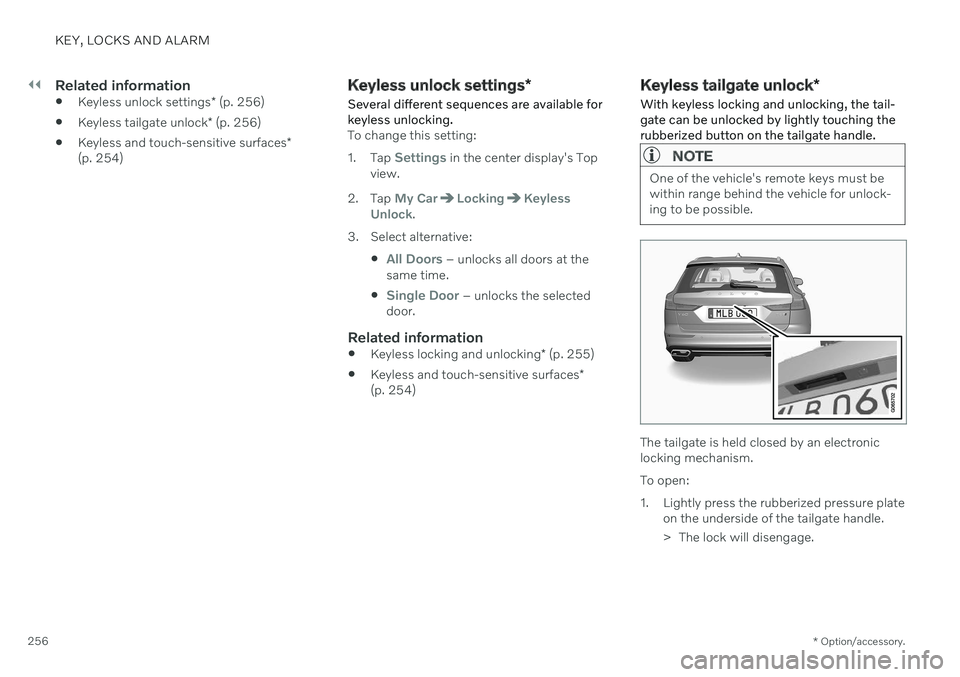
||
KEY, LOCKS AND ALARM
* Option/accessory.
256
Related information
Keyless unlock settings
* (p. 256)
Keyless tailgate unlock
* (p. 256)
Keyless and touch-sensitive surfaces
*
(p. 254)
Keyless unlock settings *
Several different sequences are available for keyless unlocking.
To change this setting: 1. Tap
Settings in the center display's Top
view.
2. Tap
My CarLockingKeyless
Unlock.
3. Select alternative:
All Doors – unlocks all doors at the
same time.
Single Door – unlocks the selected
door.
Related information
Keyless locking and unlocking
* (p. 255)
Keyless and touch-sensitive surfaces
*
(p. 254)
Keyless tailgate unlock *
With keyless locking and unlocking, the tail- gate can be unlocked by lightly touching therubberized button on the tailgate handle.
NOTE
One of the vehicle's remote keys must be within range behind the vehicle for unlock-ing to be possible.
The tailgate is held closed by an electronic locking mechanism. To open:
1. Lightly press the rubberized pressure plate on the underside of the tailgate handle.
> The lock will disengage.
Page 259 of 661

KEY, LOCKS AND ALARM
* Option/accessory.257
2. Lift the outer handle to open the tailgate.
CAUTION
Only light pressure on the rubberized pressure plate is necessary to releasethe tailgate's locking mechanism.
Use the handle to lift the tailgate and donot apply force to the rubberized pres-sure plate. Too much force can damagethe pressure plate's electrical connec-tions.
Hands-free unlocking of the tailgate is also possible using a foot movement under the rearbumper; see the separate section.
WARNING
Do not drive with the tailgate open. Toxic exhaust fumes can be sucked into the vehi-cle through the cargo compartment.
Related information
Keyless locking and unlocking
* (p. 255)
Keyless and touch-sensitive surfaces
*
(p. 254)
Remote key range (p. 243)
Operating the tailgate with a foot move- ment
* (p. 263)
Antenna locations for the start and lock system
The antennas for the keyless start system and keyless locking system * are integrated in the
vehicle.
Location of the antennas:
Under the cup holder in the front section of the tunnel console
In the upper front section of the left-side rear door 10
In the upper front section of the right-side rear door10
In the cargo compartment 10
WARNING
Individuals with an implanted pacemaker should not allow the pacemaker to comecloser than 22 cm (9 in.) to the Keylesssystem antennas. The aim of this is to pre-vent disturbances between the pacemakerand the Keyless system.
Related information
Keyless and touch-sensitive surfaces
*
(p. 254)
Remote key range (p. 243)
10
Only in vehicles equipped with keyless locking and unlocking *.
Page 260 of 661
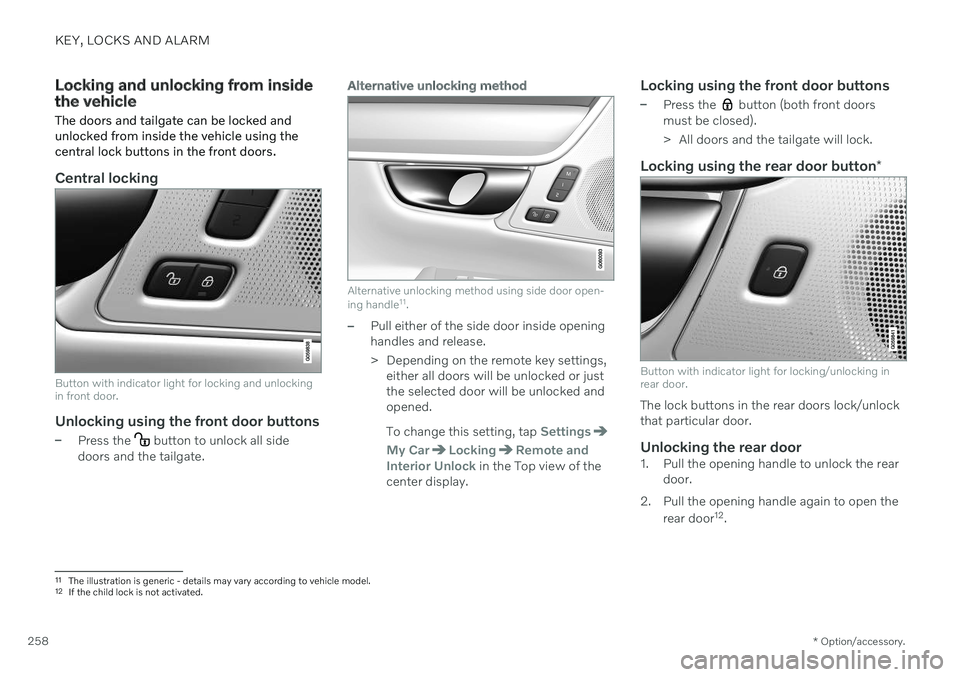
KEY, LOCKS AND ALARM
* Option/accessory.
258
Locking and unlocking from inside the vehicle The doors and tailgate can be locked and unlocked from inside the vehicle using thecentral lock buttons in the front doors.
Central locking
Button with indicator light for locking and unlocking in front door.
Unlocking using the front door buttons
–Press the button to unlock all side
doors and the tailgate.
Alternative unlocking method
Alternative unlocking method using side door open- ing handle 11
.
–Pull either of the side door inside opening handles and release.
> Depending on the remote key settings,
either all doors will be unlocked or just the selected door will be unlocked andopened. To change this setting, tap
Settings
My CarLockingRemote and
Interior Unlock in the Top view of the
center display.
Locking using the front door buttons
–Press the button (both front doors
must be closed).
> All doors and the tailgate will lock.
Locking using the rear door button *
Button with indicator light for locking/unlocking in rear door.
The lock buttons in the rear doors lock/unlock that particular door.
Unlocking the rear door1. Pull the opening handle to unlock the rear
door.
2. Pull the opening handle again to open the rear door 12
.
11 The illustration is generic - details may vary according to vehicle model.
12 If the child lock is not activated.